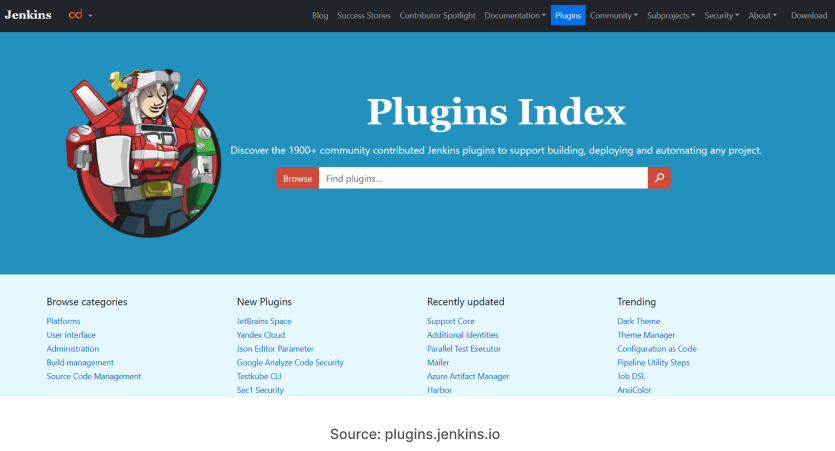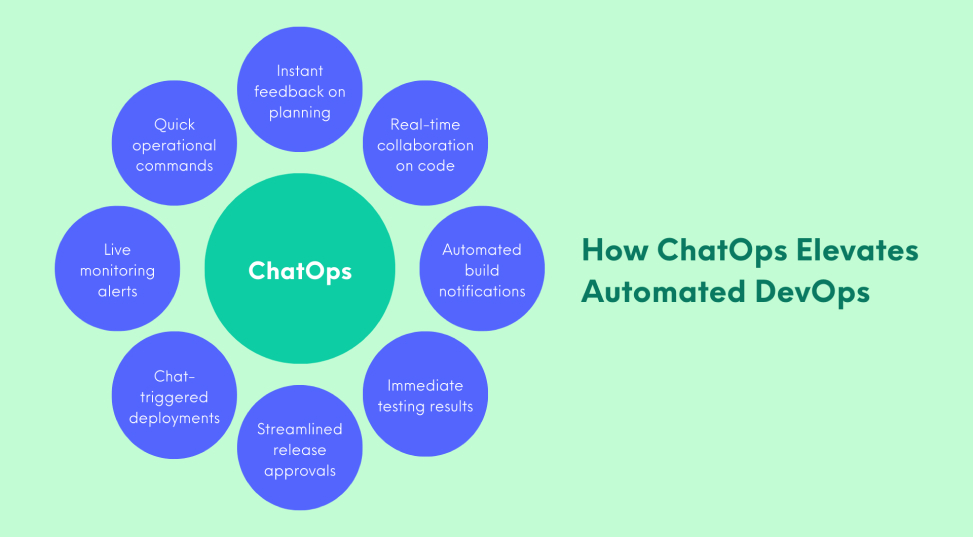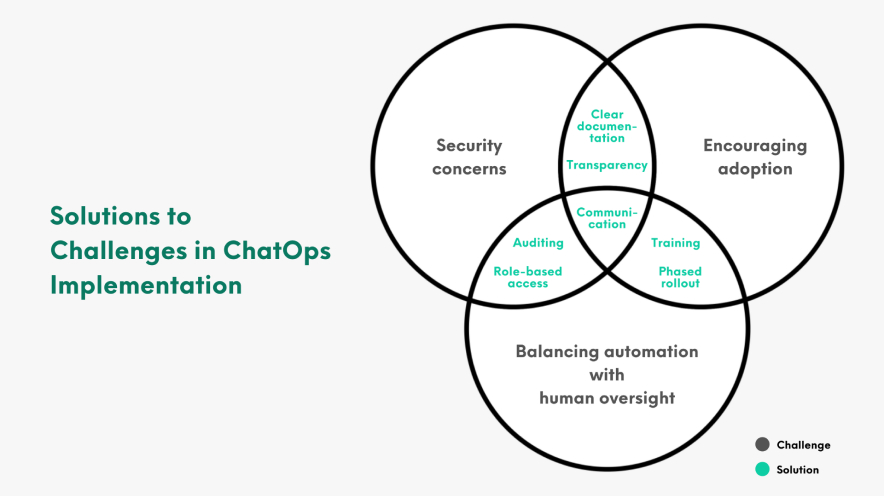Benefits of Integrating ChatOps in Automated DevOps
- | 8 minute readDevOps Automation


In today’s fast-paced tech world, especially within SaaS startups, merging ChatOps with automated DevOps processes is transforming the game.
This innovative blend of chat applications and operational tasks is streamlining workflows and enhancing team collaboration like never before.
For hustling startup leaders like you, getting to grips with ChatOps is essential for various reasons.
We’re here to break down what ChatOps is all about—its benefits, how it works, and its role in revolutionizing automated DevOps environments.
By incorporating ChatOps, startups like yours are positioned to significantly improve their efficiency, agility, and ability to tackle problems, which are crucial for standing out in the competitive tech market.
At the heart of ChatOps is the integration of communication, teamwork, and task execution within tech and software development teams. It turns chat platforms into the main workspace for handling a wide array of tasks.
The aim is straightforward: bring together people, tools, processes, and automation into one transparent and cohesive workflow, all through a chat interface.
The concept revolves around making a chat room the command center for operations. Here, teams manage both technical tasks and business operations in real time, supported by three pillars:


Originating in Agile methodologies, ChatOps has evolved in response to the need for more efficient communication within software development teams.
With the rise of cloud computing and a growing demand for agile, collaborative environments, ChatOps has grown from a way to smooth out communication to a comprehensive operational management tool.
By integrating communication directly with operational workflows, ChatOps is tearing down silos, speeding up responses, and making teams more efficient.
It makes complicated processes simpler, enables decisions to be made on the fly, and enhances problem-solving capabilities, proving itself to be an indispensable tool in today’s DevOps landscape.

The fusion of ChatOps into automated DevOps environments marks a significant advancement in how operations are managed.
This combination elevates the entire DevOps cycle, from coding to deployment, by embedding real-time communication and collaboration at its heart.
The power of ChatOps within DevOps lies in its ability to enable instant communication.
Tools like Slack or Microsoft Teams evolve beyond simple messaging apps; they become dynamic spaces where teams can quickly share updates, pinpoint issues, and work together on solutions in real-time.
This shift away from slower communication methods, such as email, leads to faster problem resolution and decision-making.
With ChatOps, when an issue arises, team members can immediately come together in the chat interface.
Using chatbots, they can pull relevant data, run diagnostics, or even kick off deployments or fixes right from the chat window. This capability drastically reduces downtime and increases service reliability.
One of the greatest strengths of ChatOps is its ability to make every operation transparent.
Every action taken and every word spoken is logged in a chat channel, creating a clear, chronological record that’s invaluable for auditing, troubleshooting, and reflecting on past actions.
This level of transparency is essential for maintaining operational integrity and learning from previous experiences.
By incorporating ChatOps into DevOps workflows, routine tasks such as code deployments and setting up environments can be automated by bots.
This frees up human resources to tackle more complex and creative challenges.
A culture of immediate feedback and ongoing enhancement is inherent to ChatOps.
Developers and operational teams get real-time notifications about deployments or changes, allowing for quick adjustments and continuous improvement.
Integrating ChatOps within DevOps practices enables organizations to create a more cohesive, agile, and responsive operational environment. This integration not only accelerates processes but also fosters a culture of collaboration and continuous learning, which is essential for tech startups navigating a rapidly changing technology landscape.
The practical application of ChatOps across various forward-thinking companies showcases its transformative power in action.
Here are a couple of examples illustrating how ChatOps has been successfully implemented to streamline operations and foster a culture of transparency and rapid problem-solving.

GitHub, a cornerstone platform for software development and version control, has been at the forefront of embracing ChatOps to manage its operational workflows.
Leveraging Hubot, their own customizable chatbot, GitHub integrated chat directly into their operational processes. Hubot links to GitHub’s environment, allowing team members to deploy code, troubleshoot issues, and handle production incidents straight from their chat interface.
This ChatOps approach has significantly streamlined GitHub’s deployment process, improving transparency and team collaboration. The ability to solve problems and make decisions in real time has notably reduced deployment times and enhanced overall efficiency.

Etsy, the global marketplace for unique and creative goods, turned to ChatOps to boost its operational efficiency.
By incorporating ChatOps into their existing DevOps practices, Etsy utilized a chatbot to facilitate a range of operational tasks, including code deployment, server management, and system performance monitoring.
The integration of ChatOps led to a substantial improvement in operational response times. Real-time monitoring and alerts via the chatbot enabled the team to quickly address issues.
Moreover, this approach promoted a transparent working environment, as all actions and discussions were logged and available for reference, fostering a stronger culture of collaboration.
Adopting ChatOps within an existing DevOps framework can be a transformative move for both startups and established companies. Here are several valuable insights for a successful implementation:
By thoughtfully integrating ChatOps, you can reimagine your workflows and communication, leading to notable improvements in operational efficiency, responsiveness, and team dynamics.
While the adoption of ChatOps offers numerous benefits, it’s not without its challenges.

Addressing these issues head-on is crucial for a successful transition and to fully leverage ChatOps capabilities in your organization.
Given that ChatOps can enable the execution of operational commands, it’s vital to prioritize security measures.
Implementing robust authentication and authorization practices, along with regular audits of chat logs for unusual activities, are essential steps to ensure a secure ChatOps environment.
Change can be daunting, and the shift to ChatOps is no exception.
To facilitate smooth adoption, begin with commands and processes that are low-risk yet highly valuable.
This approach helps build confidence and familiarity within the team. As comfort with the system grows, gradually introduce more complex operations.
Automation is a key element of ChatOps, but it’s crucial to maintain a balance with human insight.
For critical operations that might require a nuanced approach, set up alerts and safeguards that necessitate human intervention.
This balance ensures that automation serves as a tool to enhance, rather than replace, the critical thinking and decision-making skills of your team.
As we look to the future, the landscape of ChatOps is set to evolve with emerging trends and technological advancements shaping its trajectory. Here are some developments to watch:
As ChatOps continues to evolve, embracing these trends will help businesses stay ahead in the dynamic field of DevOps, ensuring they are well-equipped to meet future challenges and opportunities.
At the heart of ChatOps is the promise of transforming the DevOps landscape. It offers a unique blend of immediacy, transparency, and collaboration, making it an indispensable tool for teams looking to navigate the complexities of modern software development and operations.
By integrating chatbots and real-time messaging into the fabric of DevOps processes, organizations can achieve a level of agility and responsiveness that was previously out of reach.
If you’re considering the leap into ChatOps, it’s important to approach the transition with a strategy that prioritizes clear objectives, suitable tool selection, phased integration, and a strong emphasis on security and compliance.
Equally crucial is fostering a culture of collaboration and continuous improvement, where the value of ChatOps can be fully realized through collective effort and shared insights.
At CompileCrew, we understand the intricacies of integrating ChatOps into your existing DevOps ecosystem. Our approach is tailored to meet the unique needs of your organization, ensuring a smooth transition and maximizing the benefits of ChatOps.
From selecting the right tools to fostering a culture of collaboration, our experts are here to guide you every step of the way. We prioritize security, compliance, and a phased implementation strategy that aligns with your business objectives, enabling you to achieve a seamless fusion of communication and operational command.
If you’re looking to explore enhanced DevOps solutions, feel free to connect with us and leverage our expertise as the catalyst for your startup. We’d love to build you a future where your team’s collaboration, efficiency, and problem-solving capabilities are unparalleled!

Sheena is a growth hacker at CompileCrew. She loves everything about technology and startups. When she’s not in strategy mode, you’ll find her recharging with some rock and metal music.